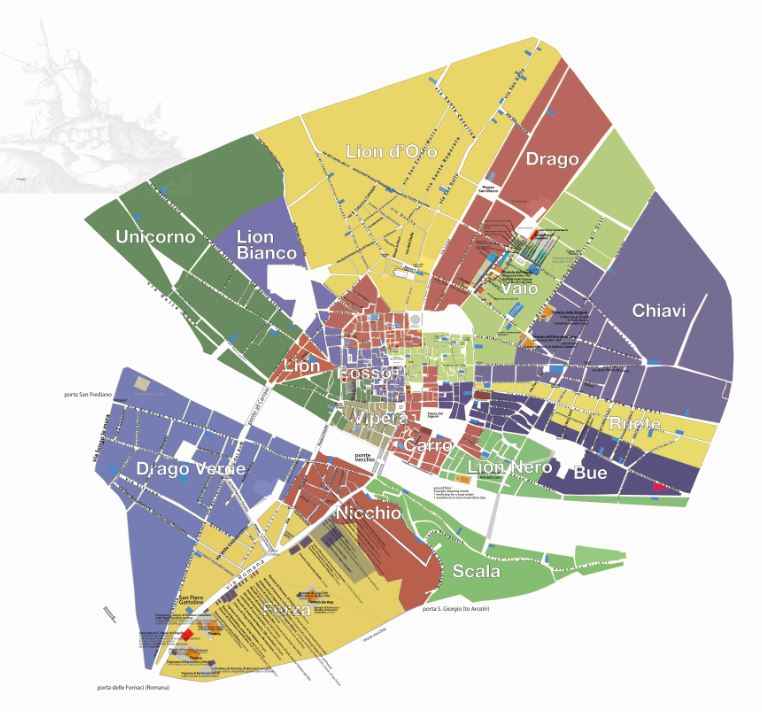Florence Illuminated project to receive generous NEH grant

By Sara Patterson
Humanities Assoc. Prof. Niall Atkinson is spearheading a comprehensive, collaborative, multi-university digital research platform called Florence Illuminated: Visualizing the History of Art, Architecture, and Society. The National Endowment for the Humanities is supporting this crucial scholarship with a grant of $349,969. It’s one of 238 humanities projects in 2024 to “help preserve and expand public access to important historical records and humanities collections at archives, libraries, museums, and universities” nationwide, according to the NEH.
The NEH grant for this project will provide a model for other digital collaborations, which will allow individual projects in the digital humanities to grow and expand on their own while also seamlessly integrating scholarship. Through a public web-based interface, the Florence Illuminated project will consolidate data from five digital humanities projects focused on the cultural history of late-medieval and early-modern Florence, supporting even more research in many fields and prompting questions that scholars haven’t even considered yet.
“Individuals can use our data to build their own datasets and make their own arguments and publications—print or digital,” said Atkinson, project director for Florence Illuminated and associate professor in the Departments of Art History and Romance Languages and Literatures at UChicago. “We can even imagine adding new projects into the core of Florence Illuminated. It will be built to last, but also to grow, as technologies advance. Our collaboration will not become obsolete but will be able to incorporate new technologies.”
The underlying technology being used on the project is the Online Cultural and Historical Research Environment (OCHRE) computational platform. Through OCHRE, the Florence Illuminated team is generating connections between the tax returns of the citizens of Florence in 1427 as part of a new taxation system to create an online, georeferenced map of Florence as it appeared that year.
The map will be enriched through links to a wide variety of data from other sources like records of church use and decoration, including burial sites; itemized household inventories; service records of military families and their weaponry; professional and political associations; and more. OCHRE uses an innovative item-based approach—not tabular models—allowing more flexibility for organizing, integrating, and analyzing heterogenous data while keeping track all of it.
“Scholars in different areas of study have collected a great deal of data about Florence,” said Torsten Reimer, University Librarian and Dean of the University Library at UChicago. “By bringing together this data, the Florence Illuminated project has real potential to foster interdisciplinary collaboration, and it allows the public to learn more about the history and culture of a fascinating city with great impact on Europe.”
Collaboration and autonomy
Atkinson and other project leaders Sidney Gause Childress Prof. George R. Bent at Washington and Lee University, Visiting Fellow Anne Leader at University of Virginia, Assoc. Prof. Peter W. Sposato of Indiana University Kokomo, and Research Fellow Lorenzo Vigotti of University of Bologna are collaborating with digital experts such as Carmen Jaramillo Caswell and Sandra Schloen at UChicago to bring their research into spatialized geographic maps and accessible information hubs. Of great interest is the Florentine Catasto, or tax consensus, of 1427, which was the first comprehensive modern assessment of a city’s population for purposes of taxation in Europe.
“Previously, projects like this have focused on a few elite families,” said Caswell, senior research analyst at the Forum for Digital Culture at UChicago. “Through the technology for this project, we are also able to place middle- and working-class families and even widows and poor of the city. This will enable people to uncover forgotten parts of Florence and want to know more about these people and understand how they lived.
“Also, we can show the relationships of people, like landlords to tenants in examples such as convents, monasteries, and hospitals, which increases the complexity and richness of available research data. It’s not just about Florence, it’s about Western civilization. I want to help scholars and the public get a better look.”
Originally designed to help archaeological research, computation, and visualization, OCHRE is the central hub around which disparate data will be brought together into a single flexible database, which will ultimately present multiple research projects on a map-based online platform that is fully searchable.
“The grant from the NEH is institutional validation that this experimentation of harmonization can be done, and that this can be a model of collaboration in digitally based humanities research in any field, where the focus of related projects intersects at varying points,” Atkinson said. “One advantage of this idea is that each project maintains its own autonomy at the same time.”
Schloen sees other advantages for using OCHRE. “Right now, these scholars are working in their own bubbles,” said Schloen, Director of Technology at the Forum for Digital Culture. “This project on OCHRE will burst those bubbles and bring them together, making it accessible and eliminating the overlaps. The scholars can talk to each other and contribute in their own way.”
Atkinson also points out that new knowledge about old places can be visualized, spatialized, and presented in ways that are meaningful to art and architectural historians. “The Florence Illuminated project connects different teams, expertise, and ultimately helps to train students in new methods that are crucial for the success of their own careers and the discipline of art history itself,” he said.